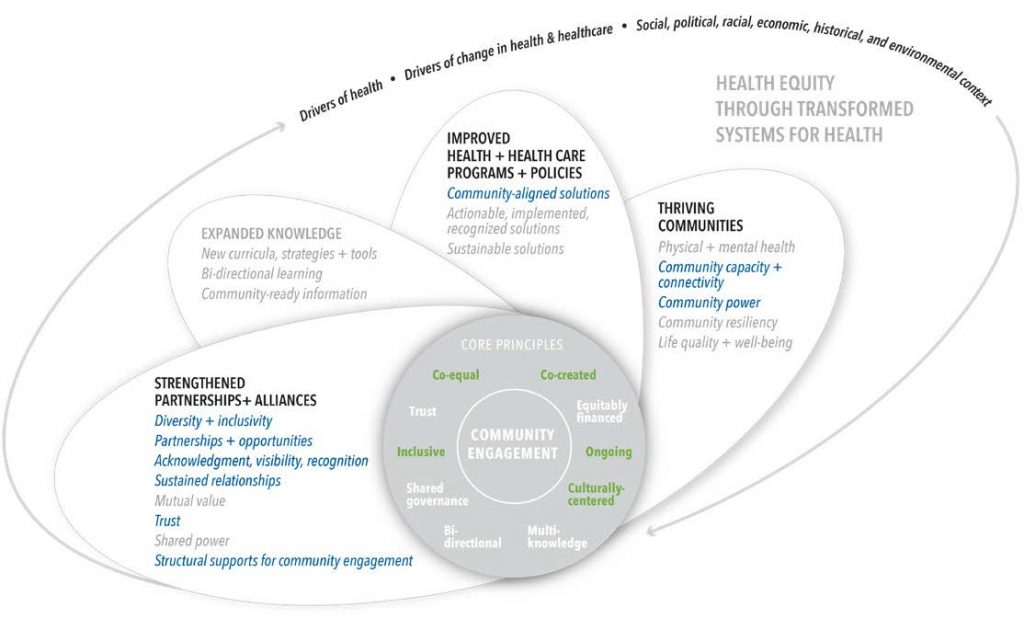
How a campaign to influence policy activated disenfranchised citizens, built community power, and drove policy change in Los Angeles county.
| TIMEFRAME | 2005 – present |
| COMMUNITY | LatinX, LGBTQ, and other underserved communities |
| GEOGRAPHY | Los Angeles, CA |
| FOCUS | Methamphetamines, HIV |
| CORE PRINCIPLES | Co-equal, Co-created, Ongoing, Culturally-centered, Inclusive |
| COMMUNITY ENGAGEMENT OUTCOMES | Strengthened Partnerships + Alliances Expanded Knowledge Improved Health + Health Care Programs + Policies Thriving Communities |
PROJECT BACKGROUND
In 2005, frustrated by rising HIV infections among LatinX gay men in Los Angeles County linked to the use of methamphetamines (meth), the Act Now Against Meth (ANAM) coalition was formed. ANAM was founded by Richard Zaldivar, Founder and Executive Director of The Wall Las Memorias Project (TWLMP), with strong support from the Asian Pacific AIDS Intervention Team. “Back then, the Los Angeles County Office of AIDS Programs found that out of every five cases of HIV, three could be attributed to meth,” Zaldivar said. The ANAM coalition was broad and intentionally grassroots, comprising local businesses, a local hospital, community leaders, faith-based organizations, educators, public health departments, and law enforcement. Their goal: to rally the community to end meth use among LGBTQ individuals in LA, especially LatinX users.
ANAM began a petition drive demanding elected and health officials take action against this growing health threat. The Los Angeles County Department of Public Health (Dept. of Public Health) had created a workgroup, “but the workgroup was slow to move and didn’t accomplish anything,” notes Mr. Zaldivar. What followed was a two-phase grassroots effort to push systems change through community action.
PHASE 1: 2005
Key engagement activities
Identified a full range of community members impacted by meth. Mr. Zaldivar looked broadly to identify the full community affected by meth use. “In 2005, they were Latina homemakers in Los Angeles County, gay and bisexual men, the HIV-positive community, those who frequented business establishments like gay bars and bath houses. We even recruited young people in high schools who were part of the campaign, and faith leaders who were cognizant… of the impact that meth was having among their congregants.”
Gathered signatures. Over the course of a year, the ANAM Coalition gathered 10,000 signatures from voters in the area, reaching deep into the community to include everyone impacted by meth use. Importantly, says Mr. Zaldivar, they held press briefings and media events: “When a story comes out in a local newspaper or an ethnic newspaper, and people see a topic that normally is not discussed at the dinner table, they will call and say, ‘I want to be part of that.’” ANAM presented its petitions to the Los Angeles County Board of Supervisors in September of 2006. The petition demanded a comprehensive response to the meth epidemic and additional funding for education, research, and treatment.
Launched a community mobilization effort. The ¡Ya Basta! (“enough is enough”) campaign uses education, leadership development, and community involvement to address the many challenges in reducing HIV/AIDS risk behaviors among LatinX gay and bisexual men.

Listen as Richard Zaldivar, Founder and Executive Director of The Wall Las Memorias Project, describes ANAM’s community outreach efforts.

PHASE 2: 2019
KEY ENGAGEMENT ACTIVITIES
After 2007, ANAM stepped back as new government programs were implemented. But the meth problem in Los Angeles County began to shift: Federal money for the opioid crisis drained attention away from meth, community organizations funded for meth interventions were not meeting the needs of the LGBTQ community, and meth use was again on the rise. In 2019, following the meth-related arrest of California political donor Ed Buck, TWLMP reactivated ANAM. They went back to the community using a multiphase effort in which they:
Hosted community conversations to collect first-person perspectives. From November 2019 to May 2020, ANAM hosted four virtual focus groups and five in-person listening sessions. Participants were identified by using street outreach at the local art walk, promoting the topic to local organizations, and emailing and calling people with whom TWLMP had existing relationships. A total of 70 gay or bisexual, trans, non-binary and cisgendered individuals—including active users of meth and those seeking treatment—as well as health educators and community members participated. These intimate discussions provided fresh insight into the effects of meth on local communities and health service providers.
Hosted a community roundtable to formulate recommendations. In July 2020, ANAM coordinated its first large online forum. Over 140 health and addiction experts, policymakers, and members of the LGBTQ community in Southern California attended. People with lived experience of meth use and dependency presented at the forum along with public health experts, laying out a diversity of perspectives. Following the session, ANAM drafted preliminary recommendations. Over the next two months, ANAM held a series of smaller community dialogues (35 people total) to further develop recommendations for addressing meth use. In October 2020, ANAM convened a third meeting, this time with 25 service providers, to share the work of ANAM and next steps in the campaign.
Convened a government roundtable. In December 2020, ANAM convened a second roundtable with community members and county officials to present recommendations and advance the conversation about addressing meth in Los Angeles. Over 40 public officials participated, and a subset of participants consisting of professionals from relevant fields formed a workgroup to help plan and lead a community summit.
Coordinated a community summit to revise recommendations. Returning to the community, ANAM and the workgroup held a three-part meeting in which over 200 community members participated. Breakout sessions generated specific recommendations on prevention, treatment, and policy ideas related to meth use.
Co-developed a platform paper. The workgroup split into prevention, treatment, and policy subgroups to draft final recommendations. After five months and 54 hours of effort, the resulting four-page platform paper assembled input from 17 community-based organizations (CBOs) and presented their demands and requests for meth prevention, treatment, and policy change. In December 2021, ANAM presented the platform paper to coalition and community members for approval and adoption. Over 40 individuals participated in a line-by-line review.
Outcomes
ANAM engaged almost 600 people at the local, county, and state levels in its effort to create new programs to reduce meth use and advocate for policy change. Twenty-three nonprofits, groups, and community organizations signed on for the new collaboration. The community power is “awesome,” as Mr. Zaldivar notes, “because you have some large nonprofit organizations, you have some smaller ones, you have some gay, you have some straight. And they’re all working together, having their voice expressed in this Los Angeles County Act Now Against Meth platform.” When such efforts succeed, community groups see they have power. “What we also found is that for an underserved community, as they go through this process, there is an increase in self-esteem. They get to see, ‘Wow, we can make changes in government if we work together, if we strategize and we execute,’ which really is powerful.” ANAM planned to deliver its platform paper to the Los Angeles County Board in early 2022.
ASSESSING COMMUNITY ENGAGEMENT OUTCOMES
Below, the Assessing Community Engagement Conceptual Model is mapped to the Impact Story. This mapping illustrates how CORE PRINCIPLES of engagement lead to impact across the four OUTCOME domains, and to specific measurable indices within those domains.

The ANAM Coalition’s community engagement leveraged CORE PRINCIPLES of co-equal (signature-gathering by community members was valued equally to engaging politicians); co-created (petition and platform paper content was collaboratively developed); inclusive (a broad diversity of constituents was sought out); ongoing (relationships were in place for Phase 2); and culturally-centered (strategies for reaching LGBTQ, LatinX, and other underserved constituents were grounded in cultural and social knowledge of these communities).
ANAM’s approach to community engagement STRENGTHENED PARTNERSHIPS + ALLIANCES in the form of diversity + inclusivity (broad representation of underrepresented voices, such as queer people of color with lived experience of meth use, unhoused individuals, formerly incarcerated individuals, and sex workers); partnerships + opportunities (a relationship network that plugs CBOs and community members into related efforts, such as ¡Ya Basta!); and acknowledgment, visibility, recognition (TWLMP, the ANAM Coalition, and community partners have received extensive local press coverage). Fifteen years of broad community engagement has produced sustained relationships and trust (ongoing work and bilateral relationships among community members, CBOs, and Dept. of Public Health partners). The ANAM Coalition remains a robust structural support for community engagement.
The ANAM Coalition has IMPROVED HEALTH + HEALTH CARE PROGRAMS + POLICIES through community-aligned solutions ($1.6 million in funding issued in 2007 for meth treatment and prevention programs tailored to the needs of the LatinX and LGBTQ communities, as well as continued funding for the Los Angeles Department of Substance Abuse and Prevention Control).
Finally, the ANAM Coalition has led to THRIVING COMMUNITIES by building community capacity + connectivity and community power (helping the LatinX and LGBTQ communities advocate through community organizing to attain community goals, have their voices heard in the State Legislature, change their health and power outcomes, and have hope for the future).
We want to hear from you!
Assessing community engagement involves the participation of many stakeholders. Click here to share feedback on these resources, or email [email protected] and include “measure engagement” in the subject line to learn more about the NAM’s Assessing Community Engagement project.
Related Products

